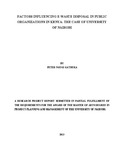| dc.description.abstract | The aim of this study was to determine the factors that influence disposal of e-waste in public
organizations, in particular at the University of Nairobi, having been selected as being
representative of the target organizations. The motivation of the study was to develop a baseline
survey on the state of e-waste at the University. Specific effort was deployed towards
investigation of the strengths and weaknesses in the handling of e-waste at the University. The
objective was, in particular, to investigate the obtaining status in regard to the influence of policy
guidelines and disposal regulations in regard to appropriate e-waste disposal, noting that e-waste
may increasingly become a major environmental concern. Further, the study sought to determine
the influence of Extended Producer Responsibility on disposal of e-waste at the University, as
well as determination of how recycling facilitation influenced disposal of e-waste. The
significance of e-waste problem in Kenya is that e-waste is relatively new and its quantities are
rapidly growing as technology becomes more common. The researcher observes that there are no
established environmentally safe disposal methods to keep pace with this change. It is important
to note e-waste contains materials that are both valuable and toxic. This then calls for a scientific
and business approach to solving the problem. The study design was of descriptive and
exploratory techniques. Semi- structured questionnaires and observation methods were deployed
to collect information from the respondents who comprised ICT, Procurement Officers and
Disposal Committee members at the University of Nairobi. Data analysis was done by both
qualitative and quantitative techniques. Quantitative data was analyzed by use of descriptive
statistics, that is, frequencies, percentages and averages. Content analysis generated the
qualitative data and was reported in narrative form. Data presentation and interpretation was
reported through the use of tables. It is anticipated that the outcome of the study will contribute
to the way forward in disposal of e-waste in public organizations, as well as assist in
implementation of immediate mitigation measures through increased awareness. The study
revealed that, the University deployed appropriate ICT procurement tools to ease the assessment
and identification of the suitable products. On the other hand, the University had failed to
adequately implement systems for vetting imports. Further, that limited capacity of relevant
government agencies to deal with e-waste and lack of public awareness on the need for safe ewaste
disposal as concerning. Lack of coordinated approach across service providers and the
University to deal with e-waste are also common challenges on e-waste disposal. Based on
findings of this study, the researcher recommends that: In relation to overall greening of public
organizations, indicators of greening the e-waste streams should include the value of - and, jobs
related to - the goods generated through the greening of the e-waste sector such as
remanufactured products and the services in terms of e-waste collection, segregation, and
processing. Economic and social benefits in terms of health, property values, as well as direct
and indirect job creation should also be included. Additional efforts are needed to collect data
and conduct quantitative analysis in all public organizations to enable policy makers to design
their strategy for greening the e- waste sector on a more informed basis. Economic and social
benefits in terms of health, property values, as well as direct and indirect job creation should also
be included. Not all of these indicators may, however, be readily available and thus may call for
further research. | en |

